Does it snow in Mexico, and where can you find the best winter escapes? Absolutely, and gaymexico.net is your ultimate guide to discovering Mexico’s snowy destinations, from majestic mountain peaks to charming winter towns, perfect for LGBTQ+ travelers seeking unique adventures. Find inclusive accommodations, activities, and travel tips for an unforgettable experience in the Mexican winter wonderland, all while planning an unforgettable snow trip.
1. Does It Snow in Mexico?
Yes, snow does fall in Mexico, primarily in the northern regions and at higher elevations throughout the country. The occurrence of snow is relatively rare, making it a unique and special experience for both locals and visitors. Snowfall is most commonly observed in mountainous areas where the altitude allows for colder temperatures, essential for snow formation.
While Mexico is renowned for its tropical beaches and warm climate, certain regions transform into winter wonderlands during specific times of the year. These areas offer stunning landscapes and opportunities for winter sports and activities, providing a different perspective on the diverse geography of Mexico.
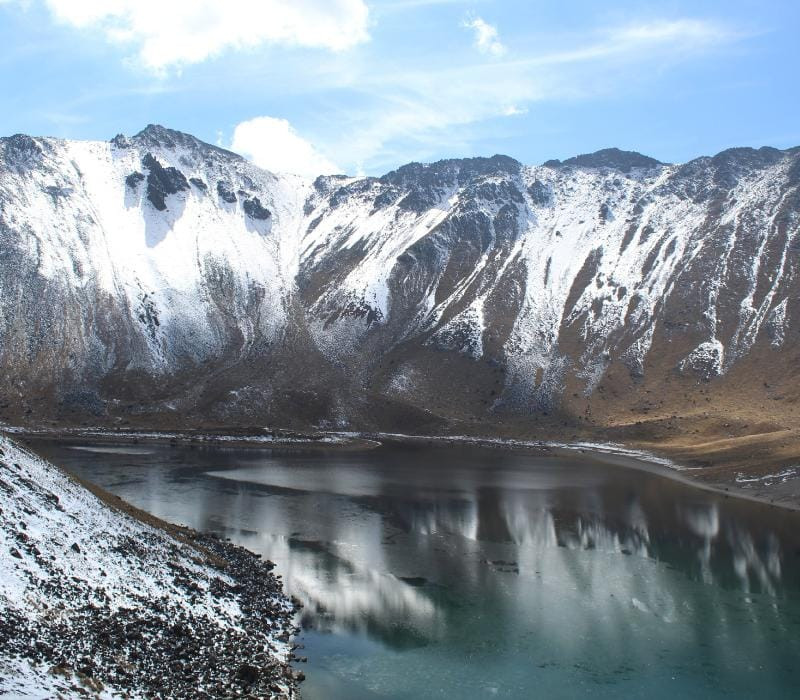 Snowy Mountain Landscape in Mexico
Snowy Mountain Landscape in Mexico
2. What Part of Mexico Does It Snow In?
Snowfall in Mexico is generally confined to a few key regions. The northern states, including Chihuahua, Coahuila, and Nuevo León, are known to experience snow, especially in areas with higher elevations. Additionally, mountain ranges such as the Sierra Madre Occidental, Sierra Madre Oriental, and the Trans-Mexican Volcanic Belt occasionally receive snow. Specific high-altitude locations like Pico de Orizaba, Nevado de Toluca, and Sierra Negra are famous for consistent winter snowfall, offering picturesque views and winter activities.
According to research from the National Autonomous University of Mexico (UNAM), the northern regions experience more frequent snowfall due to their latitude and proximity to colder air masses. This makes these areas prime destinations for those seeking winter landscapes and snow-related activities in Mexico.
3. 17 Spectacular Places to Experience Snow in Mexico
3.1. Nevado de Toluca, Estado de México
Nevado de Toluca, or Xinantécatl, is a dormant volcano located about 50 miles west of Mexico City, near Toluca. Known for its large crater that houses two beautiful lakes, Laguna del Sol (Sun Lagoon) and Laguna de la Luna (Moon Lagoon), this fourth-highest peak in Mexico stands at 15,385 feet above sea level, making it a popular destination for hikers. Numerous pre-Hispanic archaeological sites surround the lakes, adding cultural significance to the landscape.
The best time to see snow here is from November to March, when temperatures range from 39°F to 57°F (4°C to 14°C). Snowfall varies, but when it occurs, it transforms the area into a stunning winter wonderland. For an enhanced experience, consider booking a guided tour with an experienced local who can lead you to the best views.
3.2. Parque Nacional Izta-Popo, Puebla and Estado de México
Parque Nacional Izta-Popo, situated between Puebla and México State, is renowned for its two towering volcanoes, Iztaccíhuatl and Popocatépetl. Established in 1935, this park is one of Mexico’s oldest and most ecologically diverse, featuring pine forests, grasslands, and alpine areas. Keep an eye out for the volcano rabbit, one of the coolest animals in Mexico, and enjoy birdwatching, with 161 bird species recorded in the area.
Hiking trails cater to different fitness levels, from easy mid-altitude walks to challenging climbs like the Iztaccíhuatl ascent. The best time to visit for snowy landscapes is between November and January. Check volcanic activity before planning a visit, as Popocatépetl’s activity can influence park accessibility.
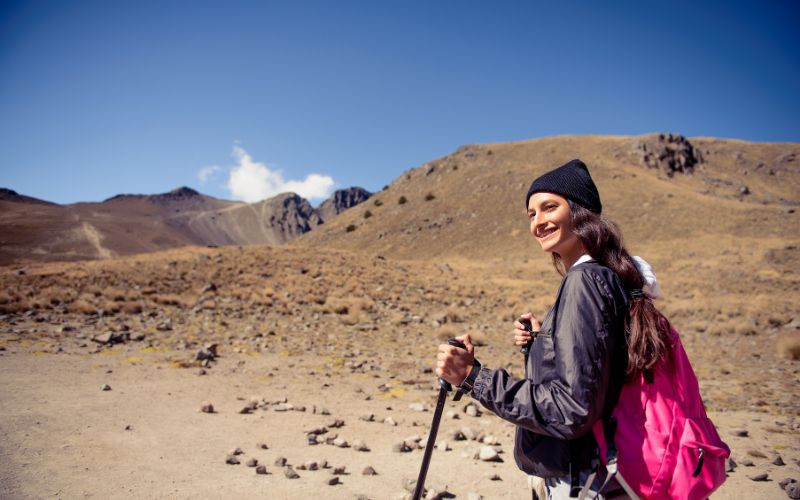 Hiker on Nevado de Toluca Trail
Hiker on Nevado de Toluca Trail
3.3. Sierra de Arteaga, Coahuila
Sierra de Arteaga, often called the Swiss Alps of Mexico, is located in Coahuila. This region is celebrated for its alpine landscapes and winter sports, being home to Bosques de Monterreal, Mexico’s only ski resort. Visit in December and January when temperatures drop to around 45°F (8°C). The resort area is surrounded by pine forests, enhancing its beauty.
In addition to skiing, enjoy golf at the highest altitude course in Mexico, tennis, basketball, horseback riding, and ATV tours. Nearby El Cielo mountain offers moderate trekking routes reaching up to 10,170 feet.
3.4. Monterreal, Coahuila
Monterreal in Coahuila is often called the Alps of Mexico, and yes, you can ski here. It features an artificial ski slope with mostly fake snow, perfect for beginners and experienced skiers, snowboarders, and sledding enthusiasts. The region experiences natural snowfall during the winter months, adding to its winter sports appeal.
Located in Sierra de Arteaga, Monterreal is surrounded by forests and offers various outdoor activities, including golfing, tennis, and mountain biking. According to the resort’s website, Monterreal consistently updates its facilities to ensure a premium winter sports experience for all visitors.
3.5. Barranca del Cobre, Chihuahua
Barranca del Cobre, or Copper Canyon, is a network of canyons in Chihuahua, offering a landscape more extensive and deeper than the Grand Canyon. Accessible via the El Chepe Train, which travels from Chihuahua to Los Mochis, this area offers spectacular views and stops at key points like Creel.
The best time to visit to see snow is from December to March. Besides hiking, enjoy mountain biking, rock climbing, and zip-lining. The area is also rich in biodiversity, offering wildlife spotting and bird watching opportunities. The Sierra Tarahumara region surrounding the Copper Canyon sees significant snowfall, enhancing the area’s natural beauty.
3.6. Creel, Chihuahua
Creel, located in the Sierra Tarahumara of Chihuahua, is known for its magical winter landscapes, particularly from December to February. With snowfall, this high-altitude town becomes a picturesque winter destination, highlighting the beauty of the Copper Canyon area.
Average winter temperatures range from highs around 57°F (13.9°C) to lows around 30°F (-1°C), occasionally dipping below 22°F (-5.5°C). Creel is a popular gateway for exploring the rugged terrains of the Copper Canyon, offering activities such as hiking and cultural visits to the indigenous Tarahumara communities.
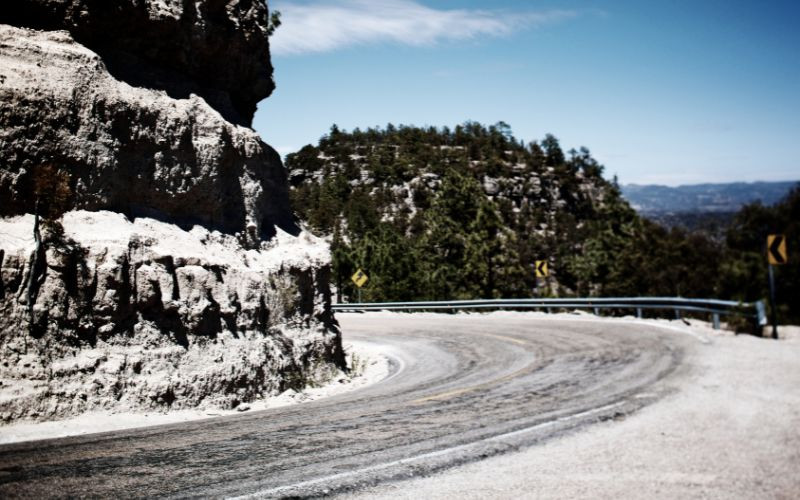 Snowy Highway Leading to Copper Canyon
Snowy Highway Leading to Copper Canyon
3.7. La Malinche, Tlaxcala and Puebla
La Malinche, a dormant volcano on the border between Tlaxcala and Puebla, is a popular hiking and climbing destination. Standing at over 14,600 feet, it offers challenging trails that are popular during the snow season from December to February.
The mountain’s high elevation results in cooler temperatures, frequently below freezing. The park surrounding La Malinche is rich in biodiversity, with dense forests and wildlife. Due to the altitude, hiking here can be quite demanding, so it’s recommended to acclimatize and prepare for temperature variations.
3.8. Parque Nacional Pico de Orizaba, Puebla and Veracruz
Pico de Orizaba is the tallest peak in Mexico and the third highest in North America. Located on the border between Puebla and Veracruz, this park is famous for its volcano that has glaciers and a year-round snow-capped summit. Rising approximately 18,491 feet above sea level, it’s the perfect spot for advanced mountaineering.
Climbing Pico de Orizaba is a popular activity, attracting both beginner and experienced mountaineers. The ascent involves using crampons and an ice axe due to icy conditions near the summit. For those not ready for such a climb, the park offers easier activities and views of the snow-capped mountain.
3.9. Volcán de Colima, Colima and Jalisco
Volcán de Colima, part of the Colima Volcanic Complex, is another place to see snow, particularly at higher altitudes during winter. The summit, reaching about 13,386 feet, often receives a blanket of snow, creating a dramatic shift in scenery.
The area is popular for hiking and bird watching, providing a unique environment where tropical and alpine conditions merge. According to the University of Guadalajara’s environmental studies department, the diverse ecosystems around Volcán de Colima make it a hotspot for biodiversity.
3.10. Cerro del Ajusco, Mexico City
Located about 12.5 miles from Mexico City, Cerro del Ajusco is a peak in the Ajusco mountain range, standing at 12,894 feet. This is one of the most accessible spots for snow in the region, attracting visitors looking for snow activities close to the capital.
During the winter months from December to February, the higher elevations of Ajusco can experience snowfall. It also offers hiking and mountain biking, as well as panoramic views of Mexico City and the surrounding volcanic belt. The proximity to Mexico City makes it a convenient destination for a quick winter escape.
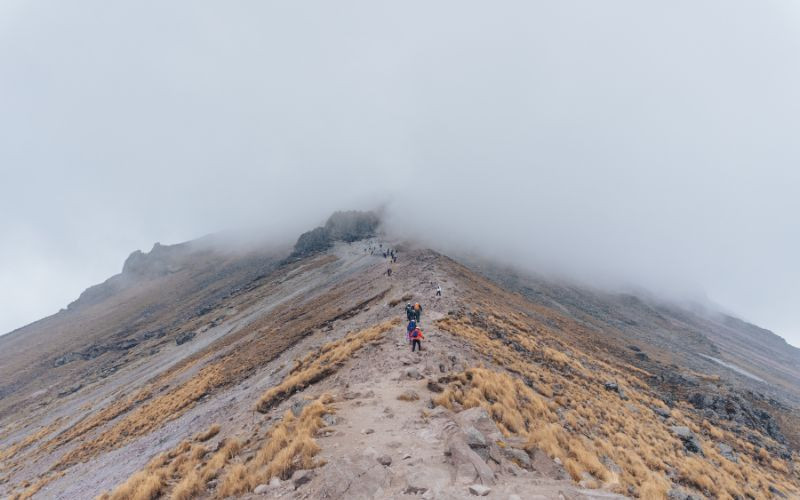 Hikers on La Malinche Trail
Hikers on La Malinche Trail
3.11. Cumbres de Majalca, Chihuahua
Cumbres de Majalca National Park, located north of Chihuahua City, features unique rock formations and pine forests. This lesser-known park offers a quiet retreat for nature lovers who want to go hiking and see snow in winter, particularly from December through February.
The park’s elevation provides scenic views and wildlife spotting opportunities, making it a great destination for those looking to escape crowded tourist spots. The park’s unique geological formations add to the visual appeal of the snow-covered landscape.
3.12. Mexiquillo, Durango
Mexiquillo is an incredible spot in the Sierra Madre range of Durango, known for its landscapes and regular snowfall during winter. The best time to visit for snow enthusiasts is between December and February, when this area offers snow tubing and hiking through snow-covered trails.
The natural setting is enhanced by stunning waterfalls and lush forests, which become magical in the snow. The combination of waterfalls and snowy landscapes makes Mexiquillo a unique and picturesque destination.
3.13. Nevado de Colima, Jalisco
Nevado de Colima, located in Jalisco, is part of the Volcán de Colima volcanic complex. Due to its high altitude, it is one of the few places in Mexico where snow is seen regularly.
The park around Nevado de Colima is ideal for hiking and nature observation, offering a cooler refuge with its alpine environment. Snowfall occurs mainly during winter, from December to March, transforming the landscape into a scenic winter wonderland. The contrast between the volcanic terrain and the snow-covered peaks creates a visually stunning landscape.
3.14. Parque Nacional Lagunas de Zempoala, Morelos and Mexico State
Parque Nacional Lagunas de Zempoala, known for its seven lakes, is located between Morelos and the State of Mexico. This park is also known for its mountainous landscape, which occasionally receives snow in the colder months, particularly at the higher elevations.
The environment is ideal for hiking, picnicking, and wildlife observation. When snow falls, it adds beauty to the scenic vistas. The lakes themselves are a major attraction, and the occasional snowfall only enhances their charm.
3.15. La Marquesa, Mexico City and Mexico State
La Marquesa, officially known as Parque Nacional Insurgente Miguel Hidalgo y Costilla, is a popular getaway between Mexico City and the State of Mexico. If you’re looking for snow near Mexico City without climbing mountains, La Marquesa is perfect.
During snowy days, La Marquesa transforms into a picturesque landscape ideal for family outings with tubing, snowball fights, and other snow play. In warmer months, the park offers outdoor activities like horseback riding, ATV rides, hiking, and trout fishing.
 Lake in Parque Nacional Lagunas de Zempoala
Lake in Parque Nacional Lagunas de Zempoala
3.16. Monte Tláloc, State of Mexico
Monte Tláloc, situated in the State of Mexico, is steeped in historical and cultural significance. As one of the highest peaks in the region, reaching about 13,517 feet, it stands imposingly in the landscape.
During the colder months from December to February, the peak occasionally sees snowfall, adding a mystical allure to its historical charm. The Aztecs revered Monte Tláloc as a sacred site, associating it with their rain god, Tláloc. Rituals were conducted at the summit to honor Tlaloc and invoke rain, as evidenced by remnants of altars and ceremonial platforms.
3.17. Cerro El Potosí, Nuevo León
Cerro El Potosí in Nuevo León is known for its stark and rugged beauty. Reaching up to 12,200 feet, it’s one of the highest peaks in northeastern Mexico.
This peak is notable for significant snowfall during winter, making it a key destination for those seeking snow in Mexico. Its climate and terrain make it suitable for experienced climbers and adventurers looking to experience the rarity of snow in an arid region.
4. Does It Snow in Mexico City?
Snow in Mexico City is extremely rare, having occurred only three times in the last 100 years. The Mexico City altitude, at 1.5 miles above sea level, gives it a cooler climate than other areas in Mexico.
While it gets cold during winter, actual snowfall is uncommon. The recorded snowfalls in Mexico City occurred in 1940 (small amount), January 1967 (eight inches), and December 2022 (minuscule amount).
Mexico City’s usual winter conditions involve chilly temperatures, but not the freezing conditions required for snow. Average winter temperatures range from highs around 71°F (22°C) to lows of 38°F (3°C), with January being the coldest month.
5. What is the Coldest City in Mexico?
The coldest city in Mexico is typically Creel, located in Chihuahua. Situated at a high elevation in the Sierra Tarahumara, Creel experiences very low temperatures during winter, sometimes dropping below freezing.
Creel is known for its dramatic temperature changes, and its high-altitude location contributes to its cold climate. The city’s unique geographical features make it a focal point for tourists seeking to experience the colder side of Mexico.
6. Discover Inclusive Travel on gaymexico.net
Planning a trip to Mexico as an LGBTQ+ traveler? Visit gaymexico.net for comprehensive guides, safe travel tips, and insider information on the most welcoming destinations. Whether you’re exploring the snowy peaks or vibrant cities, find LGBTQ+-friendly accommodations, events, and community connections to make your Mexican adventure unforgettable. Let gaymexico.net be your trusted resource for experiencing the best of Mexico with pride and confidence. Address: 3255 Wilshire Blvd, Los Angeles, CA 90010, United States. Phone: +1 (213) 380-2177. Website: gaymexico.net.
7. Final Thoughts: Winter Sports in Mexico?
Mexico offers a surprising variety of snowy landscapes, from Pico de Orizaba’s volcanic peaks to Sierra de Juárez’s northern heights. Despite the country’s predominantly warm climate, these higher elevations receive seasonal snowfall, making them destinations for those seeking winter sports or the novelty of snow in a country known for sun and sand. Tourists and locals cherish these colder spots, where temperatures drop enough to dust the mountains in white.
Whether planning a sunny hike or a snowy adventure, Mexico’s diverse climate ensures every visitor can find their ideal experience.
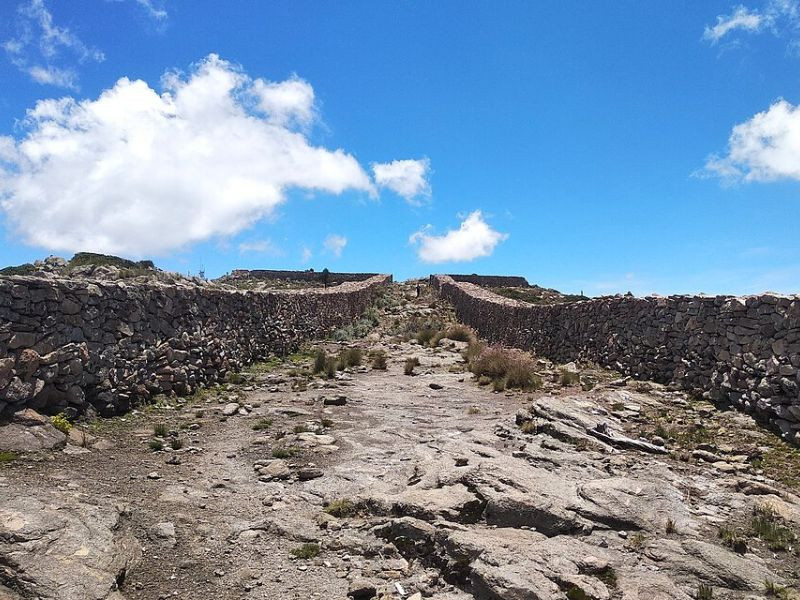 Aztec Ruins on Mount Tláloc
Aztec Ruins on Mount Tláloc
8. Frequently Asked Questions (FAQs)
8.1. Is it common for Mexico to have snow?
No, it is not common. Snow in Mexico primarily occurs in the northern regions and high-altitude areas.
8.2. What months are best for seeing snow in Mexico?
December to February are typically the best months, offering the highest chance of snowfall in the appropriate regions.
8.3. Can you ski in Mexico?
Yes, you can ski at Bosques de Monterreal in Coahuila, Mexico’s only ski resort.
8.4. What is the highest mountain in Mexico with snow?
Pico de Orizaba, also known as Citlaltépetl, is the highest peak in Mexico and features a year-round snow-capped summit.
8.5. Is Mexico City ever snowy?
Snow in Mexico City is extremely rare, with only three recorded instances in the past 100 years.
8.6. Which northern states in Mexico are likely to have snow?
Chihuahua, Coahuila, and Nuevo León are the northern states that often experience snow, especially at higher elevations.
8.7. What activities can you do in snowy regions of Mexico?
Activities include skiing, snowboarding, hiking, mountain biking, wildlife spotting, and exploring cultural sites.
8.8. Are there any precautions to take when visiting snowy areas in Mexico?
Yes, it is important to acclimatize to the altitude, bring appropriate hiking gear, wear thermal layers, and stay updated on weather conditions and volcanic activity.
8.9. How does the altitude affect snowfall in Mexico?
Higher altitudes experience colder temperatures, making them more prone to snowfall compared to lower regions.
8.10. Are there any cultural or historical sites in snowy regions of Mexico?
Yes, Nevado de Toluca and Monte Tláloc feature significant pre-Hispanic archaeological sites and ceremonial platforms.